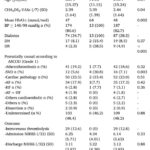Study Background and Disease Burden
Heart failure (HF) represents a significant global health challenge, with a particular burden associated with heart failure with preserved ejection fraction (HFpEF). HFpEF accounts for a substantial percentage of heart failure cases, characterized primarily by the ability of the heart to pump blood effectively while maintaining a normal ejection fraction. Patients with HFpEF commonly present with symptoms such as dyspnea, fatigue, and exercise intolerance, leading to decreased quality of life and substantial healthcare costs. Despite advancements in treatment, many patients with HFpEF experience recurrent hospitalizations and poor long-term outcomes. Sodium-glucose cotransporter 2 inhibitors (SGLT2i), such as dapagliflozin, have recently been shown to improve clinical outcomes in heart failure populations, while mineralocorticoid receptor antagonists, including spironolactone, have similarly demonstrated benefits in related heart failure cohorts. Nonetheless, there is limited data on the effectiveness and safety of the concurrent use of SGLT2i and spironolactone, which this study seeks to address.
Study Design
The SOGALDI-PEF trial was designed as a prospective randomized, open-label, blinded-endpoint crossover trial. The study aimed to compare the efficacy and safety of dapagliflozin/spironolactone combination therapy against dapagliflozin monotherapy in individuals diagnosed with HFpEF or mildly reduced ejection fraction.
A total of 108 patients were enrolled, with a primary outcome measure focused on the difference in Log N-terminal pro-B-type natriuretic peptide (NT-proBNP) levels between the two treatment groups. The trial included two treatment sequences, each administered over 12 weeks, allowing for a systematic evaluation of both treatment regimens.
Key Findings
The median age of participants was 76 years, with women comprising 57% of the cohort. The mean eGFR of participants was recorded at 72 mL/min/1.73 m², with a notable portion of the population (45%) presenting with diabetes. The primary result, examining NT-proBNP levels, indicated that the dapagliflozin/spironolactone combination significantly reduced LogNT-proBNP levels compared to dapagliflozin alone. Results revealed a mean reduction of -0.11 (95% CI: -0.22 to -0.01) Log-units, which corresponds to an 11% relative reduction (P = 0.035). Moreover, the odds ratio for achieving a ≥20% NT-proBNP reduction was notably increased to 2.27 (95% CI: 1.16–4.44; P = 0.016) in the combination group.
Secondary outcomes further demonstrated that the dapagliflozin/spironolactone combination led to a significant decline in systolic blood pressure by -5.2 mmHg (95% CI: -8.4 to -2.0 mmHg), a decrease in urinary albumin-to-creatinine ratio (-0.32 Log; 95% CI: -0.54 to -0.11 Log), and a decrease in eGFR of -6.4 mL/min/1.73 m² (95% CI: -8.3 to -4.4 mL/min/1.73 m²). Conversely, serum potassium levels increased by +0.32 mmol/L (95% CI: 0.23–0.41 mmol/L), with the frequency of elevated potassium levels (>5.5 mmol/L) increasing from 0.9% in the dapagliflozin alone group to 4.8% in the combination therapy cohort.
Expert Commentary
The findings of the SOGALDI-PEF trial offer compelling evidence regarding the efficacy of dapagliflozin in combination with spironolactone for reducing NT-proBNP levels in HFpEF patients. However, it is vital to acknowledge the increase in renal impairment and potassium levels associated with the combination therapy. These points raise questions about the clinical applicability and long-term safety of this approach, particularly in patients with existing renal profiles that may predispose them to hyperkalemia. Therefore, while the combination therapy shows excellent potential, careful monitoring and patient selection remain critically important. Future studies could elucidate the mechanisms behind the synergy of these medications, aiding clinicians in optimizing heart failure management strategies amidst evolving treatment paradigms.
Conclusion
In summary, the SOGALDI-PEF trial demonstrates that the combination of dapagliflozin and spironolactone yields a meaningful reduction in NT-proBNP levels compared to dapagliflozin alone among patients with HFpEF. This study highlights the need for further investigation into the balance between efficacy and safety of such combination therapies in broader, real-world populations, as well as exploring potential mechanisms through which these drugs may act synergistically. Together, these insights could refine treatment pathways, with the goal of improving outcomes for patients grappling with heart failure.


